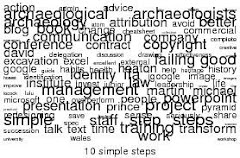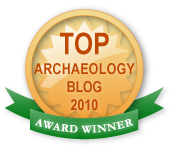A summary was published in The Archaeologist 89 (Autumn 2013), pp. 17-21.
This workshop was developed in response to a perceived gap
in opportunities to improve the standard of management in British
archaeology. Andrea Bradley of BIPC and
I share an unusual perspective on project management, since we both combine
experience of commercial archaeology with work outside archaeology and training
in the PRINCE2 formal project management methodology. There have been attempts since the 1990s to
use the wisdom and techniques of management theory in archaeological contexts,
but these have made little headway until recently. To begin with we mapped out a brisk introduction
to project management theory and terminology, but we realised as we talked
about our experience of applying it in practice that much more important than
any specific technique was the attitude of the project manager, and so we
deliberately constructed the programme to start and end with changing the
mental landscape. All effective Continuing Professional Development must be personal
development if it is make a real difference to future performance through
changed behaviour. This article
summarises the key points.
Understanding
ourselves
Although project management techniques have their place, the
need for self-awareness and reflection is greater. The workshop's first exercise explored our
individual values and priorities by identifying our most intense
experiences. For many people this came
from their leisure time or family life.
Unless we understand our drivers it is difficult for us to operate
effectively.
Exercise: Self-assessment
There are no right or
wrong answers. You will not be showing
your responses to anyone else, so be as honest as possible. The exercise consists of 4 statements, which
you are asked to score from 1 (disagree strongly) to 5 (agree strongly).
Disagree Neutral
Agree
|
|
I am competent and professional in my role
|
1 2 3 4
5
|
I find my role satisfying and productive
|
1 2 3 4
5
|
I am passionate about being involved in excavation
|
1 2 3 4
5
|
I make a positive contribution to the success of projects
|
1 2 3 4
5
|
The time you have taken to answer these questions is
probably the longest you have spent on reflection in the last year. But you answers are vital in setting any
goals for improvement. People are very
poor at evaluating their own performance -psychologists have identified the
Dunning-Kruger effect, the phenomenon where the less we know about a subject,
the more confident we are in our opinion.
This is exacerbated by the prevalence in many organisations of a culture
is "Don't ask don't tell" about people's performance, except for
annual appraisals. The rest of the time
poor performance (or good performance) is not discussed. One helpful tool is the 360 degree
evaluation, where anonymous feedback from bosses, peers and underlings allows
you to compare your idea of how you are doing with those of others. There is a free survey available from www.carregffylfan.co.uk/media.html
Projects and project
management
There is a traditional view that the management of
archaeological projects is unique bit is is archaeology, but this
exceptionalism was challenged by one of the workshop's exercises. Participants were asked to report on a recent
project that had failed and to identify the reasons for failure. The answers were: poor planning, poor
communication, insufficient time and resources, unavailability of key staff,
and inflexibility in the light of changing circumstances. Nobody reported that C14 dating or a complex
occupation phase was the problem. The
issues are generic, and precisely those that the discipline of project
management is aimed at addressing.
Project management is a distinctive subset of general
management - it gets its character from the fact that every project is temporary,
with a defined endpoint and constrained resources. As a result, projects involve compromises
between standards, scope, costs and time: a good project manager is one who
makes the right calls in the face of tough choices. Project management is not, in essence,
complex - it can be summarised as
comprising three components: talking to people, moving bits of paper around,
and thinking. Moving bits of paper
around is usually the easy bit, while thinking is often undervalued.
Formal project management defines a project as a unique
temporary activity delivered a specified change with defined budget and
resources, using skills from multiple parts of an organisation or consortium,
in order to achieve a business aim. In business,
this aim is usually to generate a profit.
Although some archaeologists would say that a successful project is one
that has the right academic or professional outputs, no organisation can afford
to lose money forever.
PRINCE2 is the widely-used method in the UK , especially
in the public sector, and its terminology and structure have become
standard. It is often perceived as
paper-intensive and excessively bureaucratic, but one of the principles is that
processes should be tailored for the project.
The key benefits of using PRINCE2 is the clarity about aims, progress
and standards which reduces the chance of catastrophic failure. Few archaeological organisations explicitly
use PRINCE2, but PRINCE2 underlies English Heritage's MoRPHE project planning
process (the replacement of Management of
Archaeological Projects (MAP2 and MAP3)).
The workshop didn't try to provide a full primer on project
management, instead focusing on the issues most relevant to archaeology.
Defining roles
Successful projects tend to have well defined roles without
overlaps or black holes, and project management therefore spends a lot of time
defining the roles and responsibilities of those involved. PRINCE2 discourages the creation of large
steering committees with periodic progress meetings in favour of a project
board restricted to those directly involved, meeting when required to make
decisions. The project board includes
representatives of the suppliers (those doing the work), end -users
(representing the client) and the corporate interests of the institution (the
project executive or director). The
project manager reports to the board, from whom authority within defined limits
is derived. When things are running to
plan, the project manager can provide brief highlight and checkpoint reports to
the board members, but this can be escalated into ad hoc advice and meetings as
soon as the project's success is threatened.
Typically the board's discussion will go like this:
Project Manager
|
Progress is behind schedule and completion is in doubt
|
Supplier
|
We need more time and/or resources to complete the work
|
User
|
We need to ensure that standards are maintained if we are
to achieve the intended aims
|
Executive
|
Providing more resources will reduce the profit generated
|
These tensions are inherent in any project governance
structure - the power of assigning roles like this is in providing a forum and
process by which these can be balanced.
Defining the
structure
Projects often involve numerous contractors, subcontractors,
and stakeholders, in addition to the hierarchy of the project team itself. It is helpful to draw this structure and
share it with others. Since
communication is vital, every link in the structure can be thought of as an
information flow, and it is worthwhile considering the medium and frequency
with which data will be shared (formal report, email, phone call, or site
visit). Often the process of mapping
will highlights some key relationships which have no defined means of
communication at all.
Change, risk and
progress
Chang and risk is part of the project landscape. At the start, there are too many unknowns to
predict effectively what will prove possible or desirable. Good project management allows for this so
that the project manager can spot risks and opportunities early and amend plans
accordingly.
A thorny issue in archaeology is how we track progress. It is relatively easy to monitor expenditure
and activity to check spend against profile, but this doesn't address the vital
question - how much of what needs to be done has been done? In the end this is largely a judgement call,
but project managers should at least be asking themselves this question all the
time.
Changing how we work
“The place to improve the world is first in one's own heart and head
and hands, and then work outward from there.” Robert M Pirsig, Zen and the
Art of Motorcycle Maintenance
Organisations are hard to change, but it is much easier to
change our own behaviour. The workshop
ended with a series of practical tips which could be implemented immediately.
The 'Five Whys' technique of root cause analysis can be
applied to any recurrent problem, major or minor. All it needs is a partner who can ask
penetrating questions, and often the problem's solution emerges. For example: "They've run out of content
sheets on site again."
"Why?" "They didn't take enough." "Why?"
"There weren't many left in the sore." "Why?" "The
last project took most of them but didn't order more." It would be possible to devise a complex
administrative solution, but perhaps all that is needed is a note on the wall
of the store reminding people to order more when the supply is getting low.
"Lessons learned" is a phrase that originated with
PRINCE2 and has become a commonplace - continuous improvement comes from not
repeating mistakes. Even if there is no
formal post-project review (and there should be), anyone can take some time to
reflect on their experience and activity to identify what worked and what
didn't.
We also need to recognise that we are not brains on legs - our physical and emotional state can
affect our work. I have a rule: no Excel
after 4 o'clock, based on the bitter experience of re-doing financial reports
the next morning when I'm awake enough to spot the errors.
Having an impact
Those who attended the workshop found it inspiring and
positive at the time, but more importantly they have taken action on returning
to work.
"I now plan out each morning what I hope to achieve,
and review it at the end of the day"
"I make much more effort to explain the background to the
tasks and to link it to our company objectives"
"I have found myself noticing my emotional state and
deciding to postpone difficult conversations until I'm calmer"







